2009 CHEVROLET EXPRESS CARGO VAN airbag
[x] Cancel search: airbagPage 63 of 408
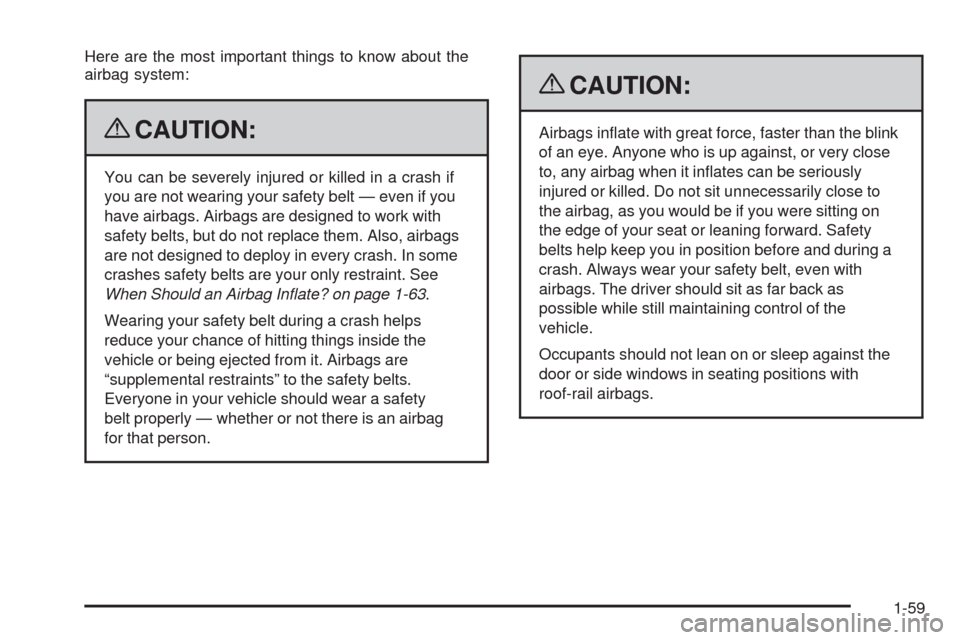
Here are the most important things to know about the
airbag system:
{CAUTION:
You can be severely injured or killed in a crash if
you are not wearing your safety belt — even if you
have airbags. Airbags are designed to work with
safety belts, but do not replace them. Also, airbags
are not designed to deploy in every crash. In some
crashes safety belts are your only restraint. See
When Should an Airbag Inflate? on page 1-63.
Wearing your safety belt during a crash helps
reduce your chance of hitting things inside the
vehicle or being ejected from it. Airbags are
“supplemental restraints” to the safety belts.
Everyone in your vehicle should wear a safety
belt properly — whether or not there is an airbag
for that person.
{CAUTION:
Airbags inflate with great force, faster than the blink
of an eye. Anyone who is up against, or very close
to, any airbag when it inflates can be seriously
injured or killed. Do not sit unnecessarily close to
the airbag, as you would be if you were sitting on
the edge of your seat or leaning forward. Safety
belts help keep you in position before and during a
crash. Always wear your safety belt, even with
airbags. The driver should sit as far back as
possible while still maintaining control of the
vehicle.
Occupants should not lean on or sleep against the
door or side windows in seating positions with
roof-rail airbags.
1-59
Page 64 of 408
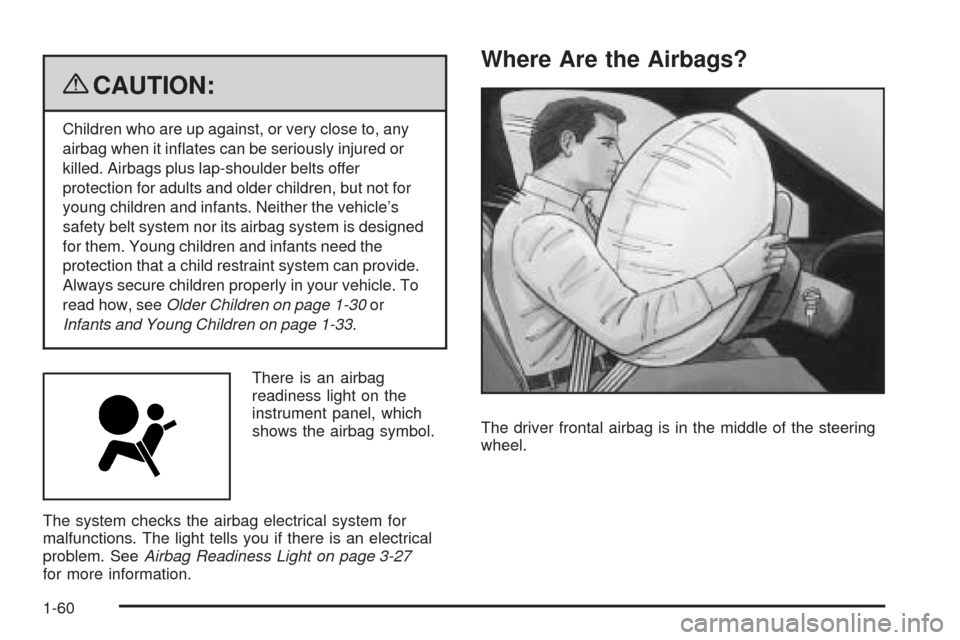
{CAUTION:
Children who are up against, or very close to, any
airbag when it inflates can be seriously injured or
killed. Airbags plus lap-shoulder belts offer
protection for adults and older children, but not for
young children and infants. Neither the vehicle’s
safety belt system nor its airbag system is designed
for them. Young children and infants need the
protection that a child restraint system can provide.
Always secure children properly in your vehicle. To
read how, seeOlder Children on page 1-30or
Infants and Young Children on page 1-33.
There is an airbag
readiness light on the
instrument panel, which
shows the airbag symbol.
The system checks the airbag electrical system for
malfunctions. The light tells you if there is an electrical
problem. SeeAirbag Readiness Light on page 3-27
for more information.
Where Are the Airbags?
The driver frontal airbag is in the middle of the steering
wheel.
1-60
Page 65 of 408
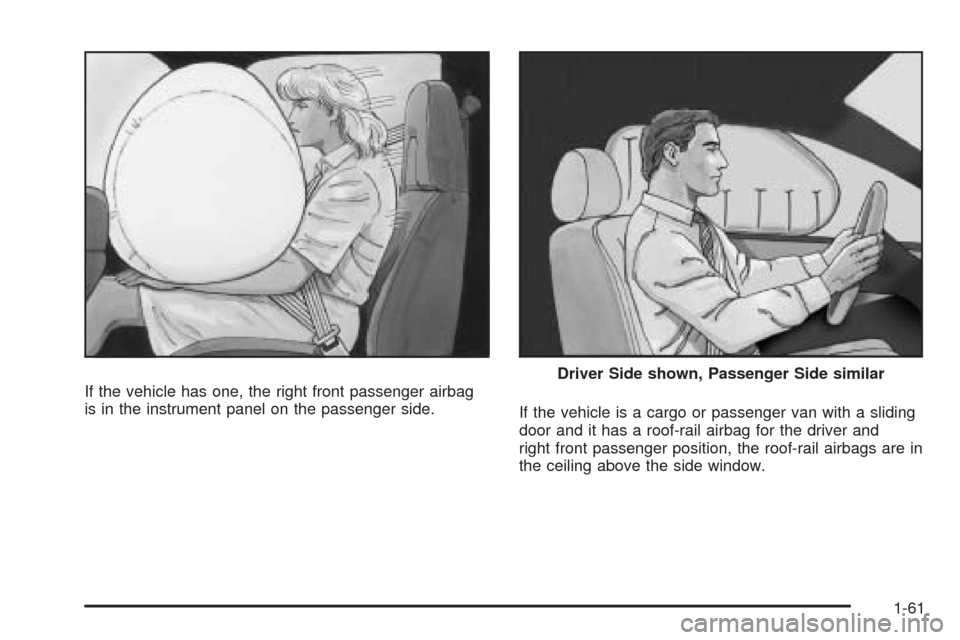
If the vehicle has one, the right front passenger airbag
is in the instrument panel on the passenger side.
If the vehicle is a cargo or passenger van with a sliding
door and it has a roof-rail airbag for the driver and
right front passenger position, the roof-rail airbags are in
the ceiling above the side window.Driver Side shown, Passenger Side similar
1-61
Page 66 of 408
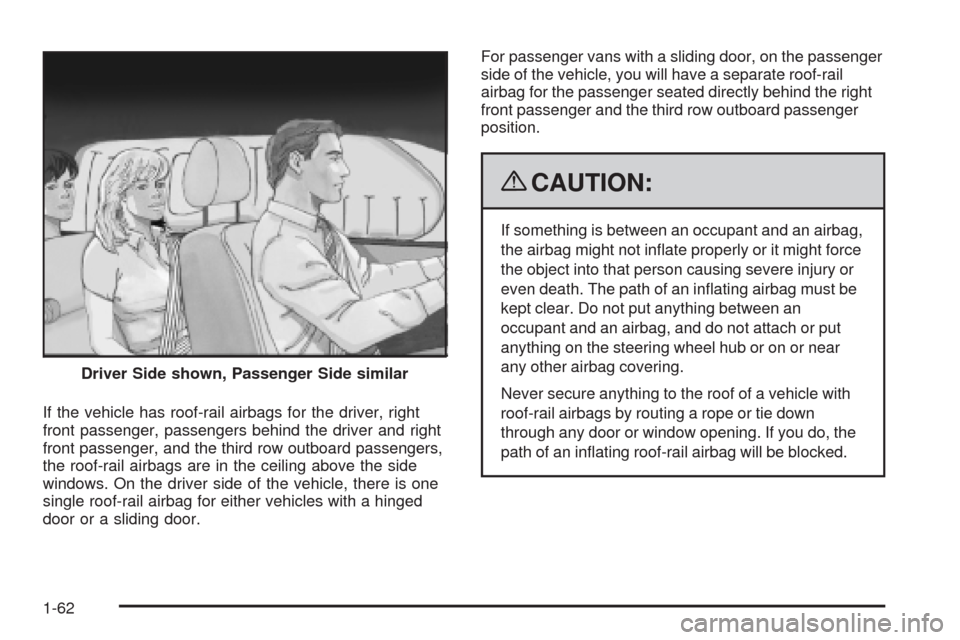
If the vehicle has roof-rail airbags for the driver, right
front passenger, passengers behind the driver and right
front passenger, and the third row outboard passengers,
the roof-rail airbags are in the ceiling above the side
windows. On the driver side of the vehicle, there is one
single roof-rail airbag for either vehicles with a hinged
door or a sliding door.For passenger vans with a sliding door, on the passenger
side of the vehicle, you will have a separate roof-rail
airbag for the passenger seated directly behind the right
front passenger and the third row outboard passenger
position.
{CAUTION:
If something is between an occupant and an airbag,
the airbag might not inflate properly or it might force
the object into that person causing severe injury or
even death. The path of an inflating airbag must be
kept clear. Do not put anything between an
occupant and an airbag, and do not attach or put
anything on the steering wheel hub or on or near
any other airbag covering.
Never secure anything to the roof of a vehicle with
roof-rail airbags by routing a rope or tie down
through any door or window opening. If you do, the
path of an inflating roof-rail airbag will be blocked. Driver Side shown, Passenger Side similar
1-62
Page 67 of 408
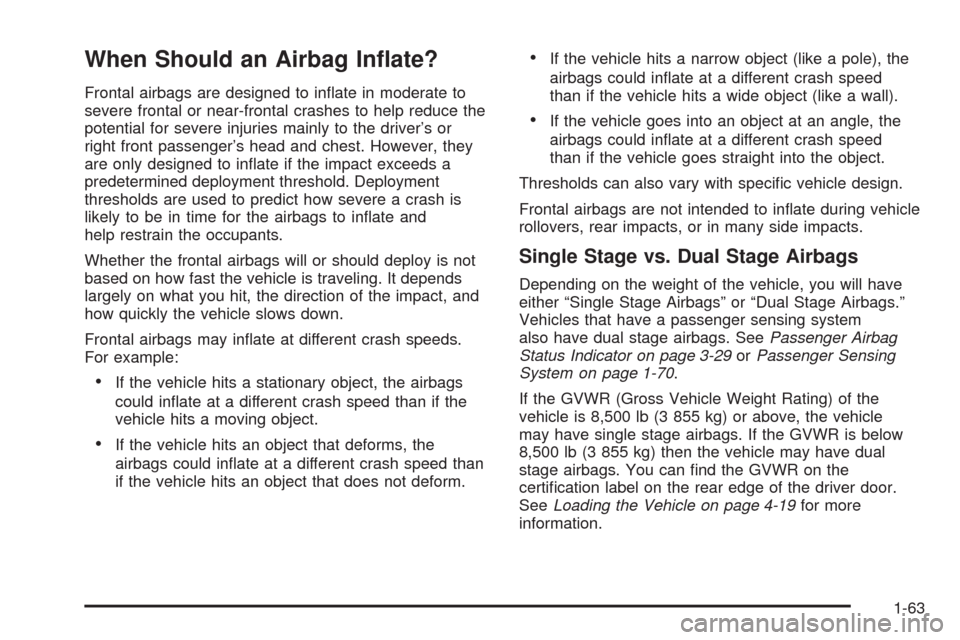
When Should an Airbag In�ate?
Frontal airbags are designed to inflate in moderate to
severe frontal or near-frontal crashes to help reduce the
potential for severe injuries mainly to the driver’s or
right front passenger’s head and chest. However, they
are only designed to inflate if the impact exceeds a
predetermined deployment threshold. Deployment
thresholds are used to predict how severe a crash is
likely to be in time for the airbags to inflate and
help restrain the occupants.
Whether the frontal airbags will or should deploy is not
based on how fast the vehicle is traveling. It depends
largely on what you hit, the direction of the impact, and
how quickly the vehicle slows down.
Frontal airbags may inflate at different crash speeds.
For example:
•If the vehicle hits a stationary object, the airbags
could inflate at a different crash speed than if the
vehicle hits a moving object.
•If the vehicle hits an object that deforms, the
airbags could inflate at a different crash speed than
if the vehicle hits an object that does not deform.
•If the vehicle hits a narrow object (like a pole), the
airbags could inflate at a different crash speed
than if the vehicle hits a wide object (like a wall).
•If the vehicle goes into an object at an angle, the
airbags could inflate at a different crash speed
than if the vehicle goes straight into the object.
Thresholds can also vary with specific vehicle design.
Frontal airbags are not intended to inflate during vehicle
rollovers, rear impacts, or in many side impacts.
Single Stage vs. Dual Stage Airbags
Depending on the weight of the vehicle, you will have
either “Single Stage Airbags” or “Dual Stage Airbags.”
Vehicles that have a passenger sensing system
also have dual stage airbags. SeePassenger Airbag
Status Indicator on page 3-29orPassenger Sensing
System on page 1-70.
If the GVWR (Gross Vehicle Weight Rating) of the
vehicle is 8,500 lb (3 855 kg) or above, the vehicle
may have single stage airbags. If the GVWR is below
8,500 lb (3 855 kg) then the vehicle may have dual
stage airbags. You can find the GVWR on the
certification label on the rear edge of the driver door.
SeeLoading the Vehicle on page 4-19for more
information.
1-63
Page 68 of 408

In addition, the vehicle may have dual-stage frontal
airbags. Dual-stage airbags adjust the restraint
according to crash severity. The vehicle has electronic
frontal sensors, which help the sensing system
distinguish between a moderate frontal impact and a
more severe frontal impact. For moderate frontal
impacts, dual-stage airbags inflate at a level less than
full deployment. For more severe frontal impacts,
full deployment occurs.
The vehicle may or may not have roof-rail airbags.
SeeAirbag System on page 1-58. Roof-rail airbags are
intended to inflate in moderate to severe side crashes.
In addition, these roof-rail airbags are intended to inflate
during a rollover. Roof-rail airbags will inflate if the
crash severity is above the system’s designed threshold
level. The threshold level can vary with specific
vehicle design.
Roof-rail airbags are not intended to inflate in frontal
impacts, near-frontal impacts, or rear impacts. All roof-rail
airbags will deploy when either side of the vehicle is
struck.In any particular crash, no one can say whether an
airbag should have inflated simply because of the
damage to a vehicle or because of what the repair costs
were. For frontal airbags, inflation is determined by what
the vehicle hits, the angle of the impact, and how quickly
the vehicle slows down. For roof-rail airbags, deployment
is determined by the location and severity of the side
impact.
What Makes an Airbag In�ate?
In a deployment event, the sensing system sends an
electrical signal triggering a release of gas from the
inflator. Gas from the inflator fills the airbag causing the
bag to break out of the cover and deploy. The inflator, the
airbag, and related hardware are all part of the airbag
module.
Frontal airbag modules are located inside the steering
wheel and instrument panel. For vehicles with roof-rail
airbags, there are airbag modules in the ceiling of the
vehicle, near the side windows for the first, second, and
third rows (if equipped). SeeWhere Are the Airbags? on
page 1-60for more information.
1-64
Page 69 of 408
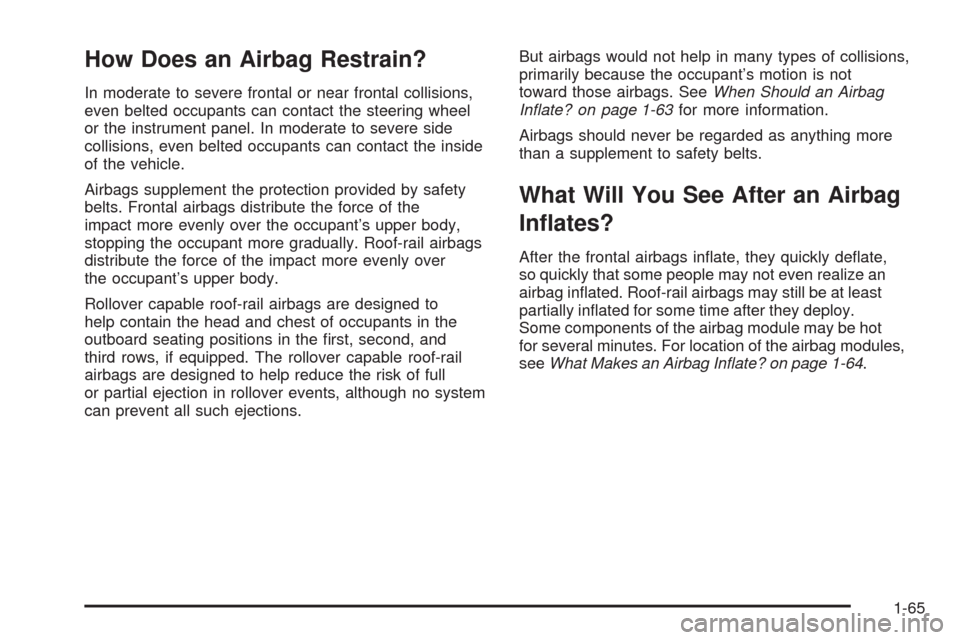
How Does an Airbag Restrain?
In moderate to severe frontal or near frontal collisions,
even belted occupants can contact the steering wheel
or the instrument panel. In moderate to severe side
collisions, even belted occupants can contact the inside
of the vehicle.
Airbags supplement the protection provided by safety
belts. Frontal airbags distribute the force of the
impact more evenly over the occupant’s upper body,
stopping the occupant more gradually. Roof-rail airbags
distribute the force of the impact more evenly over
the occupant’s upper body.
Rollover capable roof-rail airbags are designed to
help contain the head and chest of occupants in the
outboard seating positions in the first, second, and
third rows, if equipped. The rollover capable roof-rail
airbags are designed to help reduce the risk of full
or partial ejection in rollover events, although no system
can prevent all such ejections.But airbags would not help in many types of collisions,
primarily because the occupant’s motion is not
toward those airbags. SeeWhen Should an Airbag
Inflate? on page 1-63for more information.
Airbags should never be regarded as anything more
than a supplement to safety belts.
What Will You See After an Airbag
In�ates?
After the frontal airbags inflate, they quickly deflate,
so quickly that some people may not even realize an
airbag inflated. Roof-rail airbags may still be at least
partially inflated for some time after they deploy.
Some components of the airbag module may be hot
for several minutes. For location of the airbag modules,
seeWhat Makes an Airbag Inflate? on page 1-64.
1-65
Page 70 of 408
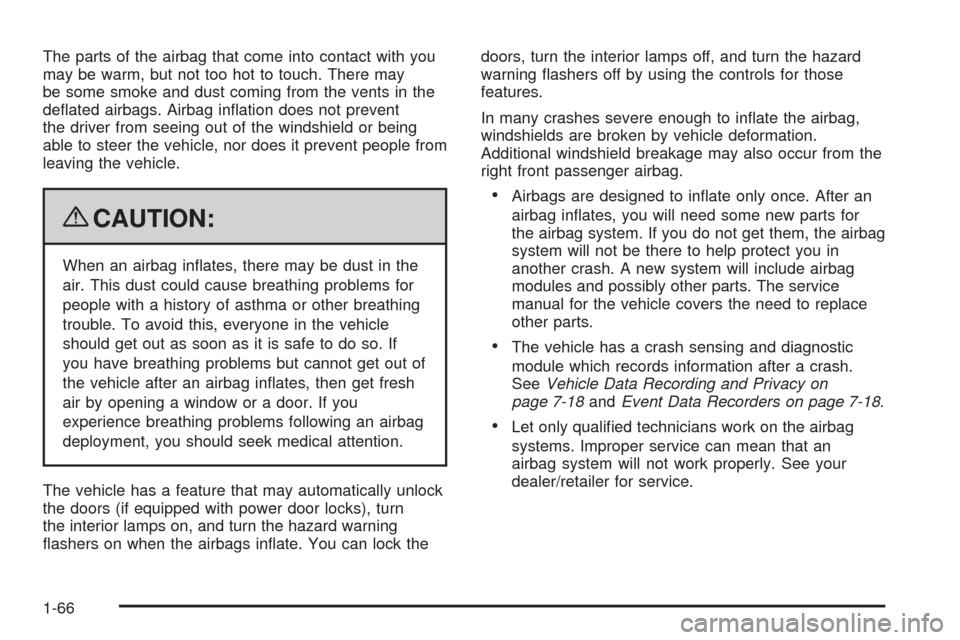
The parts of the airbag that come into contact with you
may be warm, but not too hot to touch. There may
be some smoke and dust coming from the vents in the
deflated airbags. Airbag inflation does not prevent
the driver from seeing out of the windshield or being
able to steer the vehicle, nor does it prevent people from
leaving the vehicle.
{CAUTION:
When an airbag inflates, there may be dust in the
air. This dust could cause breathing problems for
people with a history of asthma or other breathing
trouble. To avoid this, everyone in the vehicle
should get out as soon as it is safe to do so. If
you have breathing problems but cannot get out of
the vehicle after an airbag inflates, then get fresh
air by opening a window or a door. If you
experience breathing problems following an airbag
deployment, you should seek medical attention.
The vehicle has a feature that may automatically unlock
the doors (if equipped with power door locks), turn
the interior lamps on, and turn the hazard warning
flashers on when the airbags inflate. You can lock thedoors, turn the interior lamps off, and turn the hazard
warning flashers off by using the controls for those
features.
In many crashes severe enough to inflate the airbag,
windshields are broken by vehicle deformation.
Additional windshield breakage may also occur from the
right front passenger airbag.
•Airbags are designed to inflate only once. After an
airbag inflates, you will need some new parts for
the airbag system. If you do not get them, the airbag
system will not be there to help protect you in
another crash. A new system will include airbag
modules and possibly other parts. The service
manual for the vehicle covers the need to replace
other parts.
•The vehicle has a crash sensing and diagnostic
module which records information after a crash.
SeeVehicle Data Recording and Privacy on
page 7-18andEvent Data Recorders on page 7-18.
•Let only qualified technicians work on the airbag
systems. Improper service can mean that an
airbag system will not work properly. See your
dealer/retailer for service.
1-66